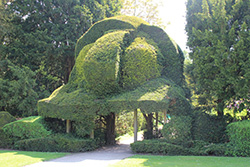
In order to remain a permanent feature throughout the season the traditional materials of choice for topiary have been evergreens, with typically box and yew being used to create the best effects.
A widely acclaimed gardener, William Barron, was invited to Elvaston in 1830 to create for the fourth Earl of Harrington ‘a garden second to none’. He was among the first to pioneer a radical new method of tree transplanting which involved specimen mature trees being transported vertically, with the root ball intact. This minimised stress and damage to the tree.
A near 100% survival rate was achieved using this method. Over the next 20 years many different sizes of evergreen trees and bushes, including massive established topiary pieces, were bought and moved from their original locations to Elvaston using this technique.
One topiary arbour in yew which was 14 feet square and 18 feet high was moved for a distance of 25 miles.
One of William Barron’s major achievements, of which he was justly proud, was the Crown Bush (pictured) which involved the grafting of the golden yew onto the common yew incorporating the same root stock. This feat had never been achieved before and was his jealously guarded secret.